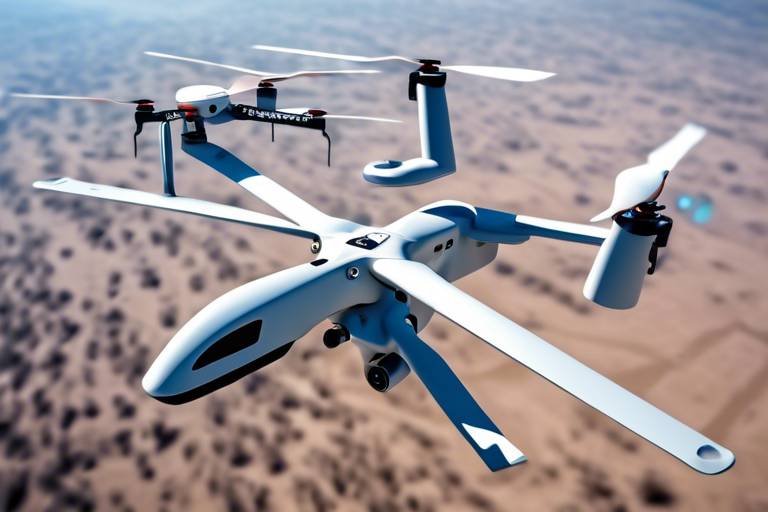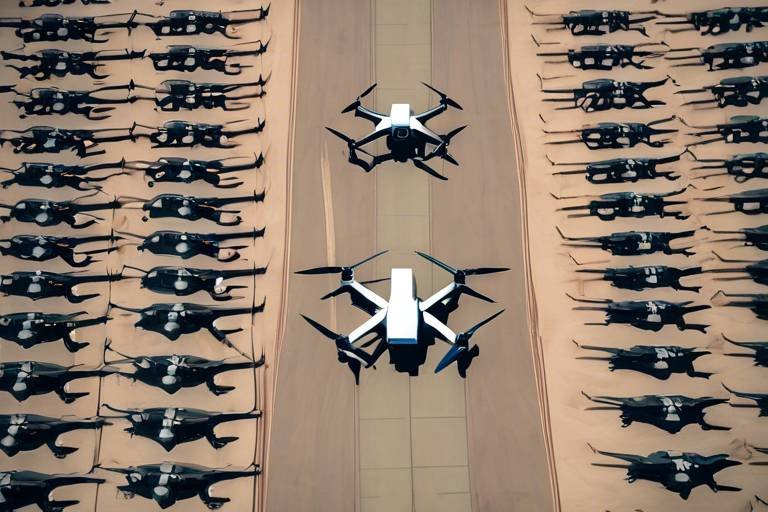Quantum Technologies for Advanced Radar Systems
In today's fast-paced technological landscape, the intersection of quantum mechanics and radar systems is paving the way for revolutionary advancements. Imagine a world where radar systems can detect even the stealthiest of objects with pinpoint accuracy. This is not just a dream; it's becoming a reality through the integration of quantum technologies. By harnessing the principles of quantum mechanics, we are unlocking new levels of performance, accuracy, and capability in various applications, including defense, aviation, and environmental monitoring.
So, what exactly does this mean for radar technology? Traditional radar systems have served us well, but they come with limitations, particularly when it comes to detecting low-observable targets. Quantum radar, on the other hand, promises to revolutionize this field by utilizing the unique properties of quantum states to enhance detection capabilities. Think of it as upgrading from a basic flashlight to a high-powered laser; the difference in clarity and reach is astounding.
As we delve deeper into this exciting topic, we'll explore the foundational principles of quantum mechanics that empower these advanced radar systems. We'll also examine the key components that make quantum radar a game-changer, including single-photon detectors and entangled photons. Each of these elements plays a critical role in enhancing the sensitivity and efficiency of radar systems, allowing them to operate in environments where classical systems struggle.
Moreover, the applications of quantum radar extend far beyond military use; they have significant implications for aviation safety and environmental monitoring as well. Imagine being able to detect aircraft in adverse weather conditions or monitoring environmental changes with unprecedented accuracy. The potential is limitless!
However, it’s essential to recognize that with great potential comes significant challenges. The development of quantum radar systems faces various technical and practical hurdles, including maintaining quantum states and the cost implications associated with advanced technologies. As we navigate through these challenges, we must also consider the future of quantum radar systems and their implications for national security, commercial aviation, and environmental monitoring.
In this article, we will take a comprehensive look at these topics, exploring how quantum technologies are set to transform radar systems and what that means for the future. Buckle up as we embark on this journey into the fascinating world of quantum radar!
- What is quantum radar? Quantum radar is a type of radar system that utilizes the principles of quantum mechanics to improve detection capabilities, especially for stealthy objects.
- How does quantum radar differ from traditional radar? Unlike traditional radar, which uses classical waves, quantum radar employs quantum states, such as entangled photons, to enhance sensitivity and reduce noise.
- What are the main applications of quantum radar? Quantum radar has potential applications in military surveillance, aviation safety, and environmental monitoring.
- What challenges does quantum radar face? The main challenges include technological limitations, cost implications, and the need for advanced materials and techniques.
- What is the future of quantum radar systems? The future of quantum radar systems looks promising, with ongoing research and development expected to lead to significant advancements in detection capabilities.

Understanding Quantum Mechanics
When we dive into the fascinating world of quantum mechanics, we're stepping into a realm where the rules of classical physics no longer apply. Imagine a universe where particles can exist in multiple states at once, a place where the act of observing something can change its behavior. This might sound like science fiction, but it's the reality of quantum mechanics. At its core, quantum mechanics is the study of the smallest building blocks of our universe, such as atoms and subatomic particles. These principles form the bedrock of quantum technologies, including the radar systems we are exploring.
One of the most intriguing aspects of quantum mechanics is the concept of superposition. This principle suggests that a quantum system can be in a combination of states at the same time until it is measured. Think of it like flipping a coin; until you catch it, it’s both heads and tails. This idea plays a crucial role in enhancing the capabilities of radar systems, allowing them to process information in ways classical systems simply cannot.
Another fundamental principle is entanglement, where pairs or groups of particles become interconnected in such a way that the state of one particle instantly influences the state of another, regardless of the distance separating them. This phenomenon can be likened to a pair of dancers perfectly in sync, moving together even when separated by miles. In radar technology, entangled photons can be used to improve detection accuracy and reduce noise, giving quantum radar systems a significant edge over their classical counterparts.
Moreover, the concept of quantum tunneling allows particles to pass through barriers that they would not normally be able to cross according to classical physics. This principle is utilized in various technologies, including quantum computing and, importantly, in enhancing the performance of radar systems by allowing them to detect objects that would otherwise remain hidden.
In summary, understanding quantum mechanics is essential for grasping how quantum technologies can revolutionize radar systems. By leveraging principles like superposition, entanglement, and tunneling, we can achieve unprecedented levels of precision and functionality. As we continue to explore these concepts, the potential applications in fields such as defense, aviation, and environmental monitoring become even more exciting.
- What is quantum mechanics? Quantum mechanics is the branch of physics that deals with the behavior of particles at the atomic and subatomic levels, where classical physics no longer applies.
- How does superposition work? Superposition allows quantum systems to exist in multiple states simultaneously until they are measured, at which point they collapse into one of the possible states.
- What is entanglement? Entanglement is a phenomenon where particles become interconnected, such that the state of one particle instantly affects the state of another, regardless of distance.
- Why is quantum tunneling important? Quantum tunneling enables particles to pass through barriers, which can enhance the capabilities of technologies like radar systems by allowing detection of otherwise hidden objects.

Quantum Radar: An Introduction
Imagine a world where radar systems can detect objects with such precision that even the stealthiest aircraft can't hide. This is the promise of quantum radar technology, a revolutionary advancement that leverages the principles of quantum mechanics to enhance detection capabilities far beyond what classical radar systems can offer. While traditional radar relies on electromagnetic waves to bounce signals off objects, quantum radar takes a different approach, utilizing the unique properties of quantum particles, such as photons, to significantly improve performance.
One of the standout features of quantum radar is its ability to detect objects that would typically evade detection by conventional systems. This capability is particularly important in fields like defense and aviation, where stealth technology is increasingly common. By exploiting the phenomenon of quantum entanglement, quantum radar systems can achieve a remarkable enhancement in the signal-to-noise ratio. This means they can pick up faint signals amidst a sea of background noise, allowing for more accurate tracking and identification of targets.
But how does this all work? At the heart of quantum radar technology are the principles of quantum mechanics. These principles allow for the manipulation of photons in ways that classical physics simply cannot explain. For instance, when two photons become entangled, the state of one photon instantaneously influences the state of the other, regardless of the distance separating them. This unique characteristic can be harnessed to create radar signals that are less susceptible to interference and deception.
Moreover, quantum radar systems can be designed to operate in a fundamentally different way than traditional systems. Instead of continuously emitting signals and waiting for echoes, quantum radar can use single-photon detection techniques that allow it to "listen" for incoming signals with unprecedented sensitivity. This not only reduces the radar's visibility to potential threats but also enhances its ability to detect smaller and more elusive objects.
In summary, the integration of quantum technologies into radar systems represents a significant leap forward in detection capabilities. By utilizing the unique properties of quantum mechanics, quantum radar systems promise to offer enhanced performance, accuracy, and resilience against stealth technologies. As we delve deeper into the components and applications of quantum radar, it becomes clear that we are on the brink of a new era in radar technology.
- What is quantum radar? Quantum radar is an advanced radar technology that uses principles of quantum mechanics to detect objects with greater precision than classical radar systems.
- How does quantum radar differ from traditional radar? Unlike traditional radar, which relies on electromagnetic waves, quantum radar utilizes the properties of quantum particles, such as photons, to improve detection capabilities and enhance signal-to-noise ratios.
- What are the benefits of quantum radar? The primary benefits include improved detection of stealthy objects, enhanced tracking capabilities, and reduced susceptibility to interference.
- Where can quantum radar be applied? Quantum radar has potential applications in military surveillance, aviation safety, and environmental monitoring, among other fields.

Key Components of Quantum Radar
When diving into the fascinating realm of quantum radar, one quickly realizes that its success hinges on several key components that work in harmony to deliver unparalleled performance. Unlike classical radar systems, which rely on traditional electromagnetic waves, quantum radar leverages the unique properties of quantum mechanics to enhance detection capabilities. Let's explore these essential elements that make quantum radar a game-changer in various applications.
At the heart of quantum radar systems are single-photon detectors. These ingenious devices are designed to detect individual photons, the smallest units of light. Their sensitivity is far superior to that of conventional detectors, allowing quantum radar to pick up faint signals that would otherwise be lost in the noise. Imagine trying to hear a whisper in a crowded room; that’s the kind of challenge single-photon detectors help overcome in the radar world. By capturing these elusive photons, they enable the radar to detect objects that are not only far away but also stealthy in nature.
Another critical component is the use of entangled photons. Entanglement is a phenomenon where two photons become linked in such a way that the state of one instantly influences the state of the other, regardless of the distance separating them. This unique property can be harnessed to improve target detection and tracking capabilities. For instance, when one photon is transmitted towards a target and the other is kept in reserve, any interaction with the target can be detected by measuring the second photon. This creates a level of sensitivity and accuracy that classical systems simply cannot match.
Additionally, quantum radar systems utilize quantum noise reduction techniques. In essence, these techniques help mitigate the background noise that typically plagues radar systems. By exploiting the principles of quantum mechanics, these methods enhance the signal-to-noise ratio, making it easier to identify and track targets without being overwhelmed by irrelevant signals. Think of it like tuning a radio to the right frequency; with quantum noise reduction, radar systems can filter out the static and focus on the clear sound of the target.
To summarize, the key components of quantum radar—single-photon detectors, entangled photons, and quantum noise reduction techniques—work together to create a radar system that is not just an evolution of existing technology but a revolution. By harnessing the power of quantum mechanics, these systems promise to push the boundaries of what radar can achieve, making it an exciting field to watch as it continues to develop.
- What is quantum radar? Quantum radar is a type of radar technology that uses principles of quantum mechanics to enhance detection capabilities, particularly in identifying stealthy or low-reflectivity objects.
- How does a single-photon detector work? Single-photon detectors are designed to detect individual photons, allowing them to capture faint signals that traditional radar systems might miss.
- What role do entangled photons play in quantum radar? Entangled photons improve target detection and tracking by allowing one photon to influence the state of another, enhancing sensitivity and accuracy.
- What challenges does quantum radar face? Challenges include technological limitations, cost implications, and the need for advanced materials and techniques to maintain quantum states.

Single-Photon Detectors
When it comes to the realm of quantum radar systems, are nothing short of revolutionary. Imagine trying to catch a glimpse of a shooting star in the vast night sky; that’s akin to the challenge faced by traditional radar systems when detecting faint signals. Single-photon detectors, however, are like having a super-powered telescope that can spot even the dimmest of stars. These devices are designed to detect individual photons, the smallest units of light, which allows them to achieve levels of sensitivity that were once thought impossible.
The operational principles behind single-photon detectors are rooted in the fascinating world of quantum mechanics. At their core, these detectors exploit the unique properties of quantum states to identify the presence of photons with incredible accuracy. When a photon strikes the detector, it triggers a cascade of events that results in a measurable signal. This process is akin to a domino effect—one small action leads to a significant outcome. The detector's ability to register these minute signals is what sets it apart from classical detectors that often struggle in low-light conditions.
Moreover, single-photon detectors come in various types, each with its own strengths and weaknesses. For example, avalanche photodiodes and superconducting nanowire single-photon detectors (SNSPDs) are two prominent categories. Avalanche photodiodes are known for their efficiency and speed, making them suitable for a range of applications. On the other hand, SNSPDs boast remarkable timing resolution and low noise levels, which are critical for high-performance quantum radar systems. The choice of detector often depends on the specific requirements of the radar application, such as the need for speed versus sensitivity.
In addition to their impressive sensitivity, single-photon detectors also play a crucial role in enhancing the overall performance of quantum radar systems through quantum noise reduction techniques. By utilizing advanced algorithms and signal processing methods, these detectors can significantly improve the signal-to-noise ratio. This means that even in environments filled with interference, quantum radar systems can still detect and track objects with remarkable precision.
However, it's important to note that the development and implementation of single-photon detectors are not without challenges. Maintaining the delicate quantum states necessary for accurate detection can be tricky, as any disturbance can lead to errors. Additionally, these detectors often require complex cooling systems to operate efficiently, which can complicate their integration into existing radar technologies. Despite these hurdles, the advantages offered by single-photon detectors make them a focal point in the ongoing evolution of quantum radar systems.
- What is a single-photon detector?
A single-photon detector is a device that can detect individual photons, allowing for extremely sensitive measurements of light. - How do single-photon detectors work?
They operate by registering the impact of a photon, which triggers a measurable signal through a cascade of electronic events. - What are the types of single-photon detectors?
Common types include avalanche photodiodes and superconducting nanowire single-photon detectors (SNSPDs). - Why are single-photon detectors important for quantum radar?
They enhance the sensitivity and accuracy of quantum radar systems, enabling the detection of faint signals that traditional systems might miss.

Entangled Photons
When we dive into the world of quantum radar, one of the most fascinating aspects is the concept of . These are pairs of photons that are generated in such a way that the state of one instantly influences the state of the other, no matter how far apart they are. It’s almost like having a pair of magic dice that always land on the same number, regardless of the distance between them. This unique property of entanglement is what makes these photons incredibly valuable for radar systems.
In quantum radar technology, entangled photons play a crucial role in enhancing the detection and tracking capabilities of targets. When a radar system emits entangled photons, it can utilize the correlations between these photons to discern the presence of objects, even those that are typically difficult to detect, such as stealth aircraft. This is because the entangled photons can provide a clearer signal that stands out against the background noise, significantly improving the signal-to-noise ratio.
Moreover, the use of entangled photons allows for advanced techniques such as quantum illumination. This technique involves sending out a pair of entangled photons, with one photon directed toward the target and the other kept in reserve at the source. By analyzing the returning photon, the radar system can gain insights about the target's characteristics, such as its shape and speed, while simultaneously minimizing the interference from surrounding noise. This method is akin to having a flashlight that not only illuminates an object but also enhances the contrast between the object and its background.
However, generating and maintaining these entangled states is no easy feat. It requires sophisticated technology and precise conditions. For instance, entangled photons are typically produced through processes like spontaneous parametric down-conversion, where a single photon is split into two entangled photons. This process must be finely tuned to ensure that the entangled state remains stable enough for practical use in radar applications.
In summary, entangled photons are not just a theoretical concept; they are a cornerstone of modern quantum radar technology. Their unique properties allow for unprecedented levels of detection capability, pushing the boundaries of what radar systems can achieve. As researchers continue to explore and refine the use of entangled photons, we can expect to see significant advancements in various fields where precision and accuracy are paramount.
- What are entangled photons?
Entangled photons are pairs of photons whose quantum states are interconnected, meaning the state of one photon can influence the state of another, regardless of the distance separating them.
- How do entangled photons improve radar technology?
They enhance detection capabilities by improving the signal-to-noise ratio and enabling advanced techniques like quantum illumination, which allows for better target identification.
- What challenges are associated with using entangled photons in radar?
Generating and maintaining stable entangled states requires advanced technology and precise conditions, which can be difficult to achieve in practical applications.
- Can quantum radar detect stealth objects?
Yes, quantum radar systems using entangled photons have shown promise in detecting stealth objects that are typically difficult to identify with classical radar systems.

Applications of Quantum Radar
Quantum radar technology is not just a theoretical concept; it has real-world applications that can significantly transform various sectors. One of the most notable areas is military surveillance, where the ability to detect stealthy objects becomes crucial. Traditional radar systems often struggle with detecting low-observable targets, but quantum radar, with its enhanced sensitivity and precision, can identify these elusive objects. This capability is particularly valuable in modern warfare, where stealth technology is prevalent.
In addition to military uses, quantum radar is making waves in aviation safety. The aviation industry constantly seeks ways to improve safety measures, and quantum radar can play a pivotal role. By providing more accurate data on the location and movement of aircraft, it can help prevent mid-air collisions and improve air traffic management. Imagine an air traffic control system that can detect every aircraft, even those operating under stealth conditions, leading to safer skies for everyone.
Moreover, the applications extend to environmental monitoring. Quantum radar can be used to track wildlife, monitor climate changes, and even detect pollution levels in various environments. For instance, researchers could utilize quantum radar to monitor the migration patterns of endangered species without disturbing their natural habitats. The precision of quantum radar allows for detailed mapping of ecosystems, which can lead to better conservation strategies.
Furthermore, quantum radar systems can aid in disaster management. During natural disasters like hurricanes or floods, these advanced radar systems can provide real-time data on weather patterns and changes in terrain. This information can be crucial for emergency responders, allowing them to make informed decisions and potentially save lives. The ability to detect changes in the environment with high accuracy can also help in predicting disasters before they strike.
To summarize, the applications of quantum radar extend across multiple domains, including:
- Military Surveillance: Enhanced detection of stealth technology.
- Aviation Safety: Improved aircraft tracking and collision avoidance.
- Environmental Monitoring: Detailed mapping and tracking of wildlife and climate changes.
- Disaster Management: Real-time data for better emergency response.
As we can see, the integration of quantum radar into these sectors not only enhances existing capabilities but also opens up new possibilities for innovation and safety. The future is bright for quantum radar technology, and its applications are poised to make a significant impact.
Q1: What is quantum radar?
Quantum radar is an advanced radar technology that utilizes principles of quantum mechanics to enhance detection capabilities, particularly for stealthy or low-observable objects.
Q2: How does quantum radar differ from traditional radar?
Unlike traditional radar, which relies on electromagnetic waves, quantum radar uses quantum states of light, such as entangled photons, to improve sensitivity and reduce noise, making it more effective in various applications.
Q3: What are the primary applications of quantum radar?
Quantum radar has applications in military surveillance, aviation safety, environmental monitoring, and disaster management, providing enhanced detection and tracking capabilities across these sectors.
Q4: Are there any challenges in implementing quantum radar technology?
Yes, there are several challenges, including technological limitations, high costs, and the need for advanced materials and techniques for effective implementation.
Q5: What is the future outlook for quantum radar systems?
The future of quantum radar systems looks promising, with potential advancements that could revolutionize national security, commercial aviation, and environmental monitoring.

Challenges in Quantum Radar Development
The journey towards fully realizing quantum radar systems is not without its hurdles. As promising as these technologies are, they face a myriad of challenges that can hinder their development and implementation. These challenges can be broadly categorized into technical limitations, cost implications, and issues with accessibility. Understanding these barriers is crucial for anyone interested in the future of radar technology and its potential applications in various fields.
One of the most significant challenges is the technological limitations inherent in quantum radar systems. Maintaining quantum states is a delicate process, akin to balancing a feather on the tip of your finger. Quantum states can easily be disrupted by environmental factors, leading to a loss of information and functionality. This sensitivity necessitates the development of advanced materials and techniques to ensure stability and reliability. Researchers are actively exploring solutions, but the complexity of quantum mechanics often poses a steep learning curve.
Moreover, the cost and accessibility of quantum radar technologies cannot be overlooked. The sophisticated components required for quantum radar, such as single-photon detectors and entangled photon sources, often come with hefty price tags. This financial barrier can be a significant deterrent for many organizations, especially smaller enterprises or those in developing regions. As a result, the widespread adoption of quantum radar may be limited unless costs can be reduced and technologies made more accessible.
In addition to these challenges, integrating quantum radar systems with existing technologies presents another layer of complexity. Many industries have established radar systems that are deeply embedded in their operations. Transitioning to quantum radar requires not just new hardware but also a rethinking of operational protocols. This integration challenge can lead to resistance from stakeholders who are accustomed to traditional systems, making the path to innovation even more convoluted.
Despite these challenges, the potential benefits of quantum radar systems are too significant to ignore. With ongoing research and development, the hope is that solutions will emerge to overcome these obstacles. As we look to the future, it’s essential to keep pushing the boundaries of what’s possible in radar technology.
- What are the main challenges in developing quantum radar systems?
The primary challenges include technological limitations, high costs, and difficulties in integrating with existing systems. - Why are quantum states difficult to maintain?
Quantum states are highly sensitive to environmental disturbances, which can disrupt the delicate balance needed for their operation. - How can the costs of quantum radar technologies be reduced?
Innovations in materials and manufacturing processes may help lower costs, making the technology more accessible. - What industries could benefit from quantum radar?
Potential applications span military surveillance, aviation safety, and environmental monitoring, among others.

Technological Limitations
While the promise of quantum radar technology is undeniably exciting, it is essential to acknowledge the that currently hinder its development and widespread implementation. One of the primary challenges lies in the maintenance of quantum states. Quantum systems are notoriously fragile, and their states can be easily disrupted by environmental factors such as temperature fluctuations and electromagnetic interference. This sensitivity can lead to a loss of information, which is critical for the precision that quantum radar aims to achieve.
Another significant limitation is the requirement for advanced materials and techniques to create and manipulate quantum states effectively. Many of the components necessary for quantum radar, such as single-photon detectors and entangled photon sources, are still in the experimental phase or have not yet reached commercial viability. This gap between research and practical application can slow down the transition from theoretical models to functional systems.
Moreover, the complexity of integrating quantum radar with existing radar technologies presents another layer of challenge. Traditional radar systems have been developed over decades, and retrofitting them with quantum capabilities requires not just technical innovation but also a significant investment of time and resources. The need for interoperability between new quantum systems and legacy technologies cannot be overstated, as the military and aviation sectors rely heavily on established systems for their operations.
In addition to these technical challenges, there are also cost implications associated with developing and deploying quantum radar technologies. The research and development phase alone can be prohibitively expensive, and the costs may not be easily justifiable for many organizations, especially those in the private sector. This financial barrier can limit accessibility and slow down the adoption of quantum radar technology across various industries.
To summarize, while the potential of quantum radar systems is vast, several technological limitations must be addressed. These include:
- Maintenance of Quantum States: Fragility and sensitivity to environmental factors.
- Advanced Materials and Techniques: Need for reliable components that are still in development.
- Integration Challenges: Difficulty in retrofitting existing systems with new technology.
- Cost Implications: High expenses associated with development and deployment.
As researchers continue to explore solutions to these limitations, the future of quantum radar technology remains bright. Overcoming these hurdles will not only enhance the capabilities of radar systems but also pave the way for a new era of precision and functionality in various applications.
Q: What is quantum radar technology?
A: Quantum radar technology utilizes principles of quantum mechanics to improve the detection and tracking capabilities of radar systems, offering enhanced performance over traditional radar.
Q: What are the main benefits of quantum radar?
A: Quantum radar can significantly improve detection of stealthy objects, enhance signal-to-noise ratios, and provide higher accuracy in tracking targets.
Q: What are the primary challenges facing quantum radar development?
A: Key challenges include maintaining quantum states, the need for advanced materials, integration with existing systems, and high development costs.
Q: How does quantum radar differ from classical radar?
A: Quantum radar leverages quantum entanglement and single-photon detection, enabling it to detect objects that may be invisible to classical radar systems.

Cost and Accessibility
When discussing the development of quantum radar systems, one cannot overlook the critical factors of cost and accessibility. These elements play a significant role in determining how quickly and widely this groundbreaking technology can be adopted across various sectors. The initial investment required for quantum radar technology can be substantial, primarily due to the advanced materials and intricate systems involved in its design and implementation. For instance, the cost of single-photon detectors and the process of generating entangled photons are not trivial. Companies and governments looking to invest in quantum radar must consider whether the potential benefits outweigh these initial costs.
Moreover, the accessibility of quantum radar technology is another hurdle. Currently, the expertise required to develop and maintain these systems is limited to a select group of researchers and engineers well-versed in quantum mechanics. This scarcity of skilled professionals can lead to higher labor costs and slower progress in the field. As the technology matures, it is essential for educational institutions and organizations to foster a new generation of experts in quantum technologies.
To provide a clearer picture of the financial landscape surrounding quantum radar, consider the following table that outlines the estimated costs associated with key components:
| Component | Estimated Cost (USD) |
|---|---|
| Single-Photon Detectors | $10,000 - $50,000 |
| Entangled Photon Sources | $20,000 - $100,000 |
| Quantum Processing Units | $100,000+ |
As the table illustrates, the costs can escalate quickly, making it a challenge for smaller organizations or startups to enter the quantum radar market. Additionally, the integration of quantum radar systems with existing radar technologies adds another layer of complexity and expense, as modifications to current infrastructure may be necessary.
In conclusion, while the potential of quantum radar technology is enormous, the issues of cost and accessibility remain significant barriers. For widespread adoption to occur, advancements in technology must be accompanied by efforts to reduce costs and enhance accessibility. This could involve collaborative research initiatives, government funding, and the establishment of educational programs aimed at cultivating expertise in quantum technologies.
- What are the main challenges in implementing quantum radar technology?
The main challenges include high costs, the need for specialized knowledge, and integration with existing radar systems. - How does quantum radar improve detection capabilities?
Quantum radar utilizes quantum principles, such as entangled photons, to enhance sensitivity and reduce noise, making it effective for detecting stealthy objects. - Will quantum radar be accessible to smaller organizations?
Currently, the high costs and specialized knowledge required pose challenges for smaller organizations, but advancements in technology and education may improve accessibility in the future.

The Future of Quantum Radar Systems
The future of quantum radar systems is not just a realm of theoretical possibilities; it's a vibrant landscape brimming with potential advancements that could revolutionize how we perceive and interact with the world around us. Imagine a radar system so advanced that it can detect objects with unparalleled precision, even in the most challenging environments. This is the promise of quantum radar technology, which harnesses the peculiarities of quantum mechanics to enhance detection capabilities far beyond what classical radar can achieve.
As we look ahead, several key developments are on the horizon that could shape the future of quantum radar systems. First, advancements in quantum computing will likely play a pivotal role. By leveraging the power of quantum algorithms, radar systems could process vast amounts of data in real-time, leading to faster and more accurate detections. This capability would be particularly beneficial in military applications, where split-second decisions can mean the difference between success and failure.
Moreover, the integration of machine learning with quantum radar systems holds great promise. By training algorithms on vast datasets, these systems could learn to differentiate between various types of objects, improving their ability to identify threats or targets. This could lead to a new era of autonomous surveillance systems that require minimal human intervention, thereby enhancing safety and efficiency.
Furthermore, as quantum technologies continue to mature, we may see a reduction in the size and cost of quantum radar components. This would not only make the technology more accessible but also facilitate its integration into existing systems. For instance, imagine a commercial aircraft equipped with quantum radar that can detect turbulence or other aircraft with pinpoint accuracy, enhancing passenger safety and comfort.
However, the journey toward widespread adoption of quantum radar is not without its challenges. The technical hurdles, such as maintaining quantum states over longer distances and integrating these systems with legacy technologies, must be addressed. Additionally, the cost of developing and deploying these advanced systems remains a significant barrier. As research progresses, we can expect to see collaborations between governments, academia, and private sectors aimed at overcoming these obstacles.
In summary, the future of quantum radar systems is bright and filled with potential. As technology advances, we can anticipate significant improvements in detection capabilities, data processing, and overall system integration. Whether in defense, aviation, or environmental monitoring, the implications of these advancements could be profound, paving the way for safer skies and more secure environments.
- What is quantum radar? Quantum radar is a type of radar technology that uses principles of quantum mechanics to detect objects with higher precision and better signal-to-noise ratios compared to classical radar systems.
- How does quantum radar improve detection capabilities? Quantum radar utilizes entangled photons and single-photon detectors, which allow it to detect stealthy objects and operate effectively in challenging environments.
- What are the main challenges in developing quantum radar systems? Key challenges include maintaining quantum states, integrating with existing technologies, and addressing cost implications for widespread adoption.
- What industries could benefit from quantum radar technology? Industries such as defense, aviation, and environmental monitoring stand to benefit significantly from the advancements in quantum radar technology.
Frequently Asked Questions
-
What is quantum radar, and how does it differ from classical radar?
Quantum radar is a cutting-edge technology that leverages the principles of quantum mechanics to enhance radar systems. Unlike classical radar, which relies on electromagnetic waves, quantum radar utilizes entangled photons to detect objects. This allows for improved detection of stealthy targets and a better signal-to-noise ratio, making it significantly more effective in various applications.
-
What are the key components of a quantum radar system?
Quantum radar systems are built around several crucial components, including single-photon detectors, which enhance sensitivity, and entangled photons, which improve target detection and tracking. Additionally, quantum noise reduction techniques play a vital role in optimizing performance, allowing these systems to operate effectively even in challenging environments.
-
What applications can benefit from quantum radar technology?
Quantum radar technology has a wide range of applications across different sectors. It is particularly beneficial in military surveillance for detecting stealth aircraft, in aviation safety for improving air traffic control, and in environmental monitoring for tracking weather patterns and pollution levels. Its versatility makes it a game-changer in these fields.
-
What are the main challenges in developing quantum radar systems?
Despite its potential, the development of quantum radar systems faces several challenges. Key issues include technological limitations, such as maintaining quantum states and the need for advanced materials. Additionally, cost and accessibility pose significant barriers to widespread adoption, as these technologies can be expensive and complex to implement.
-
What does the future hold for quantum radar technology?
The future of quantum radar systems is promising, with ongoing research aimed at overcoming current limitations. Advancements in technology are expected to lead to more efficient and cost-effective solutions, which could have profound implications for national security, commercial aviation, and environmental monitoring. As these systems mature, we may see them becoming standard tools in various industries.



















